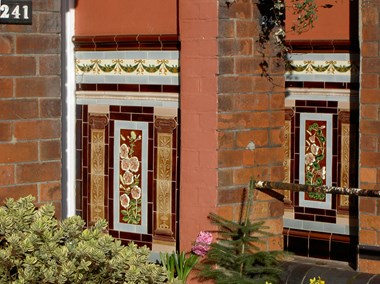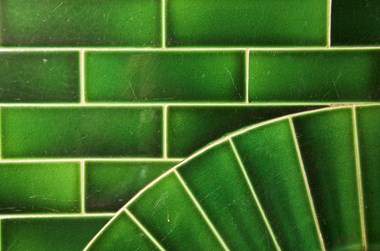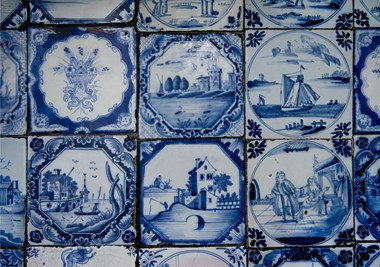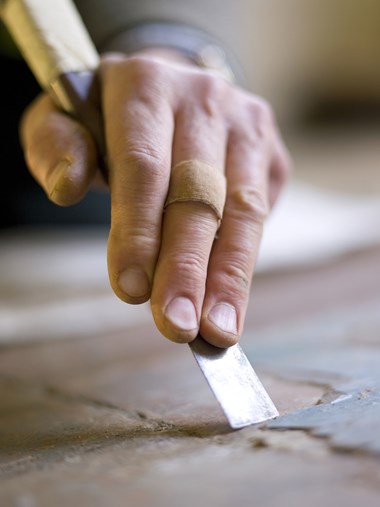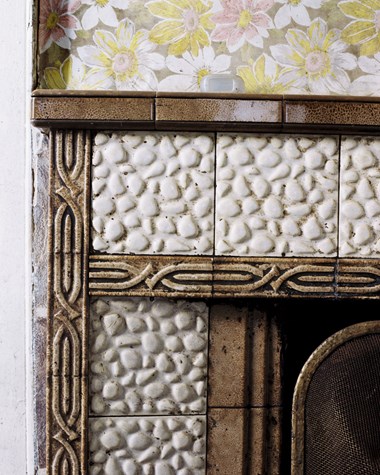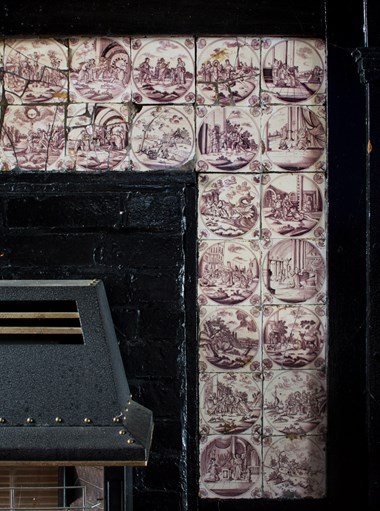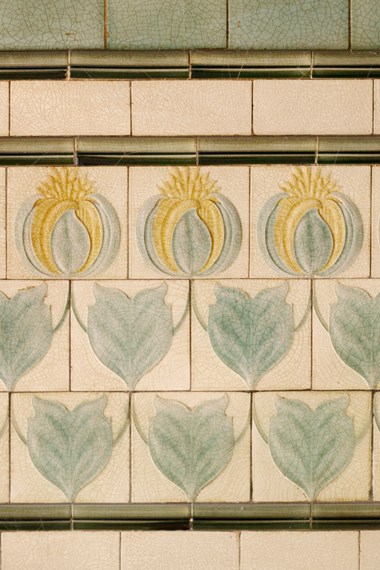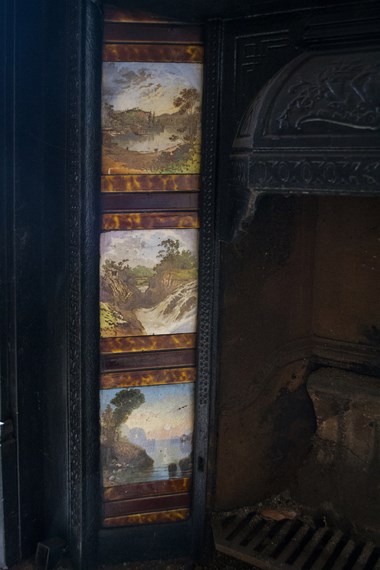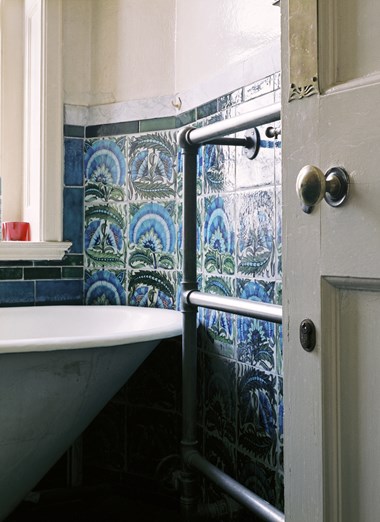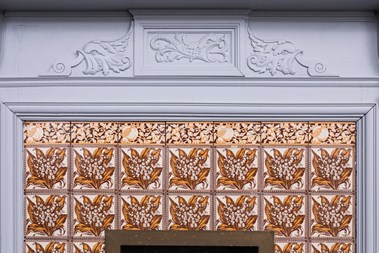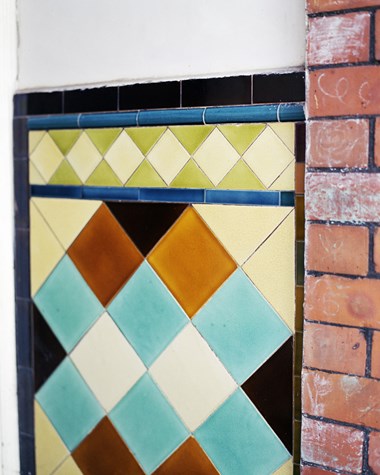Looking After Victorian, Georgian and Other Period Tiles
Many older homes still have their original floor or wall tiles. This page provides advice on how to clean them without damaging them.
Industrial tiles created colourful and cheap covering for interior surfaces, and were installed to help keep the home easy to clean. They also adorned exterior paths and front porches. They were popular with the middle classes as an elegant but affordable alternative to polished stone flooring. As an original feature they are part of the character of your home.
Please note the methods below are not suitable for earlier tiles, including fragile or porous medieval or Delft tiles. For the treatment of older and historically important tiles or ones in a more fragile condition, see our webpage on the care and conservation of tiles.
How should I clean my tiles?
Most old domestic floor and wall tiles are robust enough to withstand the low level of chemicals in ordinary cleaning products. The best method is to clean them by hand and to test your product and method on a small area first.
We recommend that you wet tiles before cleaning them. Water helps prevent the cleaning product from penetrating too deeply, but be careful not to over-wet either, to avoid salt problems or loosening tiles. Always rinse off any cleaning product you apply.
If needed, you can use a toothbrush or mildly abrasive non-scratch pads; but avoid wire wool or any hard abrasive material. You can remove hardened substances on the surface of tiles, such as paint splashes, with tools like small blades or chisels.
With glazed tiles, we recommend pH-neutral detergents (pH7). Be sure to use a cleaning pad that does not scratch the glaze, and to test on a small area first as some acid- or alkali-based products can damage blue or red-lead glazes.
On unglazed tiles, surface dirt and soiling can become more embedded. Find out how to remove various stains below.
Gallery
Please click on the gallery images to enlarge.
Stain removal tips for unglazed tiles
Here's a guide to some common methods for removing stains on robust, unglazed tiles. It includes a wide range of products for cleaning tiles but it is not an endorsement of any product or material. Remember to pre-wet and rinse off tiles with clean water before and after you apply the cleaning product.
Use environmentally sensitive products where you can. Please note that some of the products listed are toxic. Always follow the manufacturer’s directions and take health and safety precautions including protective gloves, goggles and clothing.
Blood
Chlorine-based bleach
Mix with cold water and apply the solution, then scrub the area using a natural bristled brush. To rinse, wipe using a sponge or cotton wool dampened with clean water.
Baking soda
Mix the powder with water to a paste, then place over the stain and leave for a period of time; scrape excess and rinse with clean water; repeat if necessary.
Chewing gum, wax or tar
First apply an ice cube to make gum/wax/tar brittle, then scrape off.
Coffee and food stains
Baking soda
Mix the powder with water to a paste, then place over the stain and leave for a short time; scrape excess off and rinse with clean water. Repeat if necessary.
Chlorine-based bleach
Mix with cold water and apply. Scrub the area using a natural bristled brush. Rinse with water, using a sponge or cotton wool.
Household cleaning products
Available as a powder or liquid, and can contain bleach or caustic soda; check the ingredients and follow appropriate guidelines.
Grease or fat
Mix detergent with hot water. Scrub with a natural bristle brush. Rinse with clean water, using a sponge or cotton wool.
Ink
Baking soda
Mix the powder with water to a paste, then place over the stain and leave for a short time; scrape off any excess and rinse with clean water. Repeat if necessary.
Chlorine-based bleach
Mix with cold water and apply. Scrub the area using a natural bristled brush. Rinse with water, using a sponge or cotton wool.
Limescale
Apply lemon juice (citric acid) or clear vinegar (acetic acid) on the stain, and let it dissolve or soften before scraping off. Rinse with cold water, using a sponge or cotton wool.
Mould
Ammonia
Mix the ammonia with cold water; apply and scrub manually using a natural bristled brush or toothbrush. Rinse the area with cold water, using a sponge or cotton wool.
Baking soda
Mix the powder with water to a paste, then place over the stain and leave for a short time; scrape off any excess and rinse with clean water. Repeat if necessary.
Chlorine-based bleach
Mix with cold water and apply. Scrub the area using a natural bristled brush. Rinse with water, using a sponge or cotton wool.
Paint
Apply paint remover or solvent with a small brush but use these sparingly as they may just spread the paint further. Wait for several minutes to allow paint-marks to soften. Scrape off and rinse with cold water, using a sponge or cotton wool. We recommend you test the method in a discreet area.
Gallery
Please click on the gallery images to enlarge.
Grouting
After cleaning, regrouting using a weak cement grout may give the tiles a further visual lift, and also protect the edges of the tiles in areas of frequent traffic.
Never use bees wax or linseed oil as a protective coating.


